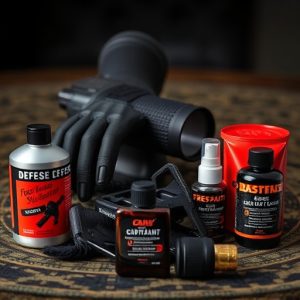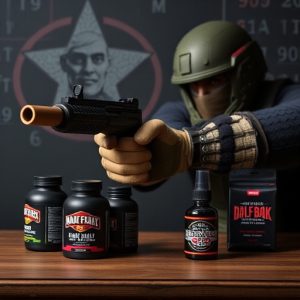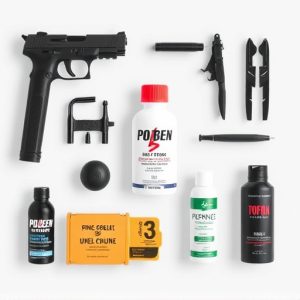Comprehensive Guide to Pepper Spray: Personal Defense and Legal Use
Pepper spray is a key element in personal defense products, offering a non-lethal and legal means o…….
Pepper spray is a key element in personal defense products, offering a non-lethal and legal means of self-defense that temporarily incapacitates attackers through intense irritation caused by capsaicin. Its effectiveness depends on the right concentration, compliance with local laws, and user proficiency, which includes proper training for accurate deployment under stress. Users must understand the legal implications, usage protocols, and limitations to maximize its deterrent potential. A suitable pepper spray should be easily accessible, have a reliable delivery system, and provide a spray pattern that suits the user's defense strategy. Safety features like UV markers and adjustable ranges are beneficial, as is matching the canister size and spray capacity to personal needs. Regular checks for leaks, functionality, and expiration are necessary to ensure the pepper spray remains effective. By adhering to these guidelines and staying informed on local regulations, individuals can confidently incorporate pepper spray into their personal defense strategy, enhancing their safety while adhering to legal standards.
When it comes to personal safety, understanding the options available for self-defense is crucial. Among the array of products designed to provide protection, pepper spray stands out as a widely recognized deterrent against potential attackers. This article delves into the critical aspects of pepper spray, from its scientific makeup and effectiveness to selecting the most suitable option for personal defense. We will also navigate the legal boundaries and best practices for employing pepper spray in self-defense scenarios, ensuring readers are well-informed on its proper use. Additionally, we’ll cover the importance of training and maintaining your pepper spray to ensure it’s an effective tool when faced with danger.
Understanding Pepper Spray: A Key Component of Personal Defense Products
Understanding pepper spray as a key component of personal defense products is essential for those looking to enhance their safety and security in potentially threatening situations. Pepper spray, also known as OC (oleoresin capsicum) spray, is a non-lethal self-defense instrument that temporarily disrupts an assailant’s vision and ability to breathe by directly impacting the eyes, nose, throat, lungs, and skin. It contains natural organic compounds derived from chili peppers, which induce an intense irritation upon contact. The effects are immediate and can incapacitate an attacker long enough for you to escape or seek help. When considering personal defense products, it’s crucial to recognize the legal implications, proper usage techniques, and potential limitations of pepper spray as a deterrent against various forms of aggression. It is designed to be effective from a distance, which provides a safe buffer between you and the aggressor, making it an invaluable tool for personal defense.
Choosing the right pepper spray among various personal defense products is important, as effectiveness can vary based on the concentration of active ingredients and the specific formulation used. It’s also essential to be aware of local laws regulating the possession and use of pepper spray, ensuring legal compliance with its use. Typically, a keychain pepper spray is easily accessible and provides a convenient means of self-defense when walking alone or in crowded areas. Additionally, understanding how to deploy it accurately and efficiently under stress is critical to its effectiveness. Training can enhance your proficiency with this defense mechanism, ensuring you are fully prepared to use it should the need arise. By integrating pepper spray into your personal defense strategy, you fortify your safety measures against physical threats in a manner that is both effective and legally permissible.
The Science Behind Pepper Spray: How It Works and Its Effectiveness Against Attackers
Capable of deterring attackers with its potent formula, pepper spray emerges as a critical component within the realm of personal defense products. Its efficacy is rooted in the active ingredient capsaicin, derived from chili peppers, which triggers an intense irritation upon contact with mucous membranes and skin. When deployed, the fine particulate matter of the spray rapidly penetrates the eyes, respiratory tract, and skin of an assailant, causing immediate and overwhelming pain. This reaction is a result of capsaicin’s interaction with the TRPV1 receptors in the skin and mucous membranes, activating them to send pain signals to the brain at an unprecedented rate. The intense sensory overload disorientates the attacker, significantly reducing their ability to continue an assault.
The science behind pepper spray is not merely about its immediate impact but also its strategic use as a non-lethal self-defense tool. Its effectiveness is further underscored by its availability as one of the most accessible personal defense products on the market. Unlike other methods of self-defense, pepper spray does not require physical strength or combat training to be effective; it serves as an equalizer in situations where one’s safety is compromised. The effects are reversible and non-permanent, making it a humane option for self-protection. Users can confidently integrate this personal defense product into their daily routines, knowing that its presence can provide a critical buffer during confrontations with potentially violent individuals.
Choosing the Right Pepper Spray for Personal Protection: Factors to Consider
When considering pepper spray as a personal defense product, it’s crucial to evaluate several factors to ensure its effectiveness in various situations. The strength of the spray, measured in Scoville Heat Units (SHU), is a primary consideration; higher SHU levels equate to more potent effects that can incapacitate an assailant. Additionally, the delivery mechanism of the pepper spray should be user-friendly and reliable under stress. Cans with keychain attachments or easily accessible storage ensure quick deployment, which is often critical in personal defense scenarios. The spray pattern also matters; a wide dispersion is beneficial for maximizing coverage, while a targeted stream can offer precision at greater distances. Safety features such as UV markers to aid in identification post-use and adjustable sprays with different ranges are valuable additions. Furthermore, the container’s size and the number of bursts it provides should align with your personal defense strategy; larger cans may offer more protection but could be less concealable, while smaller units might provide easier concealment but with fewer uses. It’s also advisable to choose a pepper spray that’s legal in your jurisdiction, adhering to local regulations regarding personal defense products. Regularly testing and practicing with your chosen product will ensure familiarity and confidence in its use when it matters most. Considering these elements, users can select the right pepper spray for their personal protection needs, tailoring their choice to fit their specific requirements and environmental contexts.
Legal Considerations and Proper Use of Pepper Spray in Self-Defense Situations
When considering the legal framework surrounding self-defense, it’s crucial to understand the regulations that govern the use of pepper spray as a personal defense product. Legally, pepper spray is permissible in many jurisdictions for personal defense, with specific stipulations on its purchase, use, and carriage. Users must familiarize themselves with state or local laws to avoid unintentional violations, which could lead to legal repercussions. The legality of pepper spray varies by region; some areas restrict its sale or possession to law enforcement officers only. It’s essential to check local ordinances before acquiring this self-defense tool.
Proper use of pepper spray is paramount for effective personal defense and legal compliance. Training in the correct application technique ensures that the spray is deployed effectively when needed, minimizing wind drift and collateral exposure. Aiming directly at an attacker’s face and maintaining a safe distance are strategies to incapacitate without causing serious harm. It’s also important to understand the limitations of pepper spray; it should be used as a deterrent rather than as a weapon in aggressive encounters. By adhering to the guidelines for use, individuals can confidently employ pepper spray as part of their personal defense products arsenal, enhancing their safety while respecting the legal boundaries set forth by authorities.
Training and Maintenance: Maximizing the Efficiency of Your Pepper Spray as a Defense Mechanism
When it comes to effectively utilizing pepper spray as a personal defense product, proper training and ongoing maintenance are key components that can significantly enhance its efficiency. Initial training should be comprehensive, covering not just the mechanics of deploying the spray but also situational awareness, legal implications, and scenario-based practice. Understanding how to aim, the optimal distance for deployment, and the potential environmental factors that could affect its efficacy are crucial. Regular drills can reinforce muscle memory, ensuring you can react swiftly and appropriately when faced with a threat.
Moreover, maintaining your pepper spray involves regular checks to ensure it is functioning correctly. This includes inspecting the canister for any leaks or corrosion, verifying that the safety mechanism operates smoothly, and checking the expiration date to guarantee potency. Environmental factors such as extreme temperatures can impact the chemical’s stability, so storage conditions should be considered to prolong its shelf life and ensure it is ready for use when needed. By prioritizing both initial training and subsequent maintenance, users of pepper spray can rely on these personal defense products to be a dependable deterrent in potentially harmful situations.


